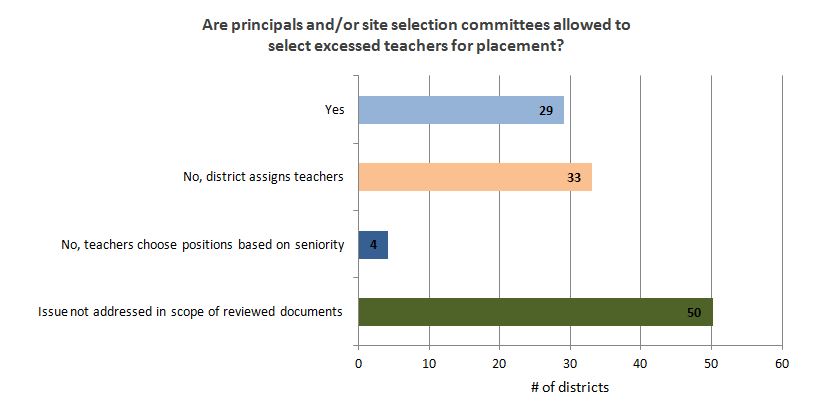District Trendline, previously known as Teacher Trendline, provides actionable research to improve district personnel policies that will strengthen the teacher workforce. Want evidence-based guidance on policies and practices that will enhance your ability to recruit, develop, and retain great teachers delivered right to your inbox each month? Subscribe here.
April 2014: Teacher excessing and placement
In this month’s Trendline, we examine what factors
determine how teachers are excessed and how excessed teachers are placed in
schools.
Teacher
excessing
Excessing teachers occurs when a school has to cut staff due
to any number of issues including, but not limited to, a drop in student
enrollment, budgetary cuts or programmatic changes. Excessed teachers are not
necessarily out of a job, but they do have to leave their current position and
find another one within the district, usually in another school. Traditionally,
districts have used seniority to determine how teachers are excessed, ensuring
teachers with the least seniority are moved first.
While there has been some change in how districts identify
teachers for excessing since we covered
this topic last year, it is clear that seniority still dominates this
identification process. Out of the 114 districts and 2 charter management
organizations in our Teacher
Contract Database, 63 percent use
seniority as the primary factor when deciding which teachers should be excessed,
compared to 11 percent that consider performance.

Notably, the districts that consider performance when
identifying teachers for excessing last year have not changed their minds.
These five districts– Cypress-Fairbanks (TX),
Denver, Douglas County (CO),
Louisiana Recovery School District and Orleans Parish –
do not consider seniority in teacher excessing and prioritize performance
during the excessing process.
Placement
after excessing
When
teachers are excessed, they are still employees of the school district and, in
most cases, are entitled by virtue of their contract to a new placement in
another school within the district. These placement decisions are made at
different administrative levels depending on the district, and they usually factor
in seniority to varying degrees.

In
a quarter of the districts in our Database, principals or a site selection
committee choose which excessed teachers are placed at their schools. In
33 districts, the HR department assigns excessed teachers to vacant positions. Four districts – Clark County (NV),
Jefferson County (CO), Little Rock and Spokane –
give excessed teachers the unusual right to choose their placement
based on their seniority, without input or approval from the principal. In
those four districts, if you’re the most senior teacher looking for a position,
you get to pick first from the list of vacancies.
Excessed
teachers who cannot find placements
In the few districts that refuse to ‘force place’ teachers
into vacancies (giving principals the right to refuse a teacher), there are
times when teachers cannot find placements after being excessed. Over a third of the districts in our Database either place these
teachers in vacancies (either with principal input or without) as they arise after
the regular hiring rounds or in temporary assignments until the teachers find permanent
positions. In eight districts, the contracts clearly state that these teachers will
eventually be exited from the system, either by being laid off or placed on
unpaid leave.
In Charlotte-Mecklenburg,
the district contract does not specify how long excessed teachers have to find
placement before they leave the district. In Clark
County (NV), Little Rock,
Manchester, Palm Beach County
and Spokane, teachers reserve recall
rights for up to two years, during which they are offered positions as they
become available based on their seniority. In Chicago, teachers are placed in a
“reassigned teacher pool” for up to 10 months, after which if they have not
secured a permanent position, they may be laid off. In Douglas
County (CO), these teachers are reassigned by the district for up to
one year, after which they are placed on unpaid leave and on a priority list
for hiring for up to two years.
The District of Columbia also
gives teachers a maximum of one year to secure permanent placement. Unlike other districts though, DC also offers these teachers a buy-out or early
retirement. Specifically, DC offers excessed teachers:
- A $25,000 buyout,
- Early retirement,
or - A year-long temporary assignment and continue
looking for a position. If they cannot find another position within that
year they will be laid off.

Why
does this all matter?
If districts do not ensure clear, fair dismissal options for
low-performing teachers, excessing often becomes a workaround solution for
principals who want to move low-performing teachers out of their schools. The
adverse effects of this are compounded when these particular teachers are
placed in vacancies in lower-performing schools, where the most vacancies
usually exist within a district.
As
districts continue to develop, implement and refine performance-based teacher
evaluation systems, we will keep track of how districts
use that information to drive various personnel decisions, including placements
for excessed teachers.

